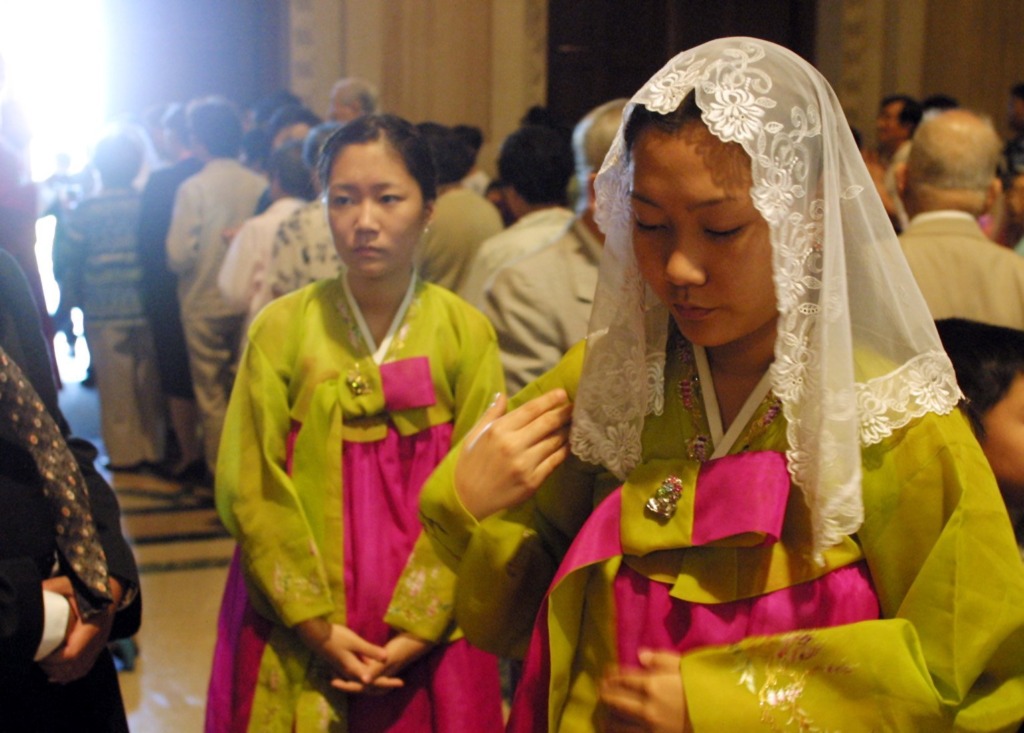What does it mean to be Asian American and Catholic? I’ve been asking myself this question a lot recently. Growing up biracial, Korean and white, my very physical identity is a blend of two cultures.
I struggled to find my identity in a context that exclusively represented the white narrative. In my books and shows, I never saw myself.
When I became a mother, I was floored when I couldn’t find dolls that looked like my kids. A strong maternal instinct arose in me to raise my kids confident in their Asian American identity and to shield them from having an experience like mine.
I continually fill our home’s shelves with books with Asian characters, for my children, but also myself. I’ve learned that seeing yourself in stories matters. It gives you a sense of confidence and a place in the world. I now feel similar tensions in our Catholic Church. Where are our stories? Who can my children look up to that look like them?
The hard reality of the U.S. Catholic Church is that it does not reflect the Asian American experience. From devotional and children’s books to conference speakers, I often come up empty when it comes to finding voices that are like my family’s.
My gut reaction is that I want to turn a blind eye. It’s hurtful to not see yourself in your Church, the most important space to feel known.
My husband and I have the unique experience of raising our family with ties to both the Korean and Chinese communities in our area. We are currently parishioners at the Chinese Catholic parish that my father-in-law, an immigrant from Taiwan, started 40 years ago.
Outside our Korean church is a statue of Mary and Jesus, Mary in a Korean “hanbok” (traditional dress), with a face that looks like my own mother’s. I remember seeing this for the first time and feeling a sense of relief. It is important to see yourself in your Church. It is no wonder that Mary is always in the native appearance of cultures she appears to.
Being Asian American and Catholic means forging our own way. When exploring how our cultural heritage influences our Easter celebrations, those I asked for insight had the same answer. There aren’t any unique traditions. It’s Catholic. Contrary to our experience in the United States, Easter is not a holiday in all of Asia.
The long history of the Church in China and Korea involved a tremendous amount of persecution, as the faith was seen as intertwined with threatening foreign influence. Embedded deep within Asian Catholic history is a complicated and tragic need to choose between cultural traditions or the Catholic faith. Many Asian martyrs have stories where within their own family, spouses or children chose different sides (Mt 10:35).
Although my father-in-law lived in Taiwan during a time when his family was able to practice their faith freely, his church was shaped by Western missionaries who didn’t come from the native culture and naturally passed on their European traditions.
“Pansori” is traditional Korean music, performed simply with voice and drums. It was born out of the suffering that early Koreans experienced during many years of foreign occupation. Early Korean Catholics who were under persecution would have chanted the Catechism of the Catholic Church and sung pansori as part of their worship.
Some Korean American communities today use pansori during Lent, as the deep emotion that permeates pansori powerfully intertwines with Jesus’ humanity and suffering. The music ties us to the stories of the generations of past Korean Catholics who came before us.
When we emerge from Lent, our Korean community’s Easter celebration is my favorite convergence of my ethnic heritage and Catholic faith. Chewy rice cakes coated in spicy sauce and cups filled with warm broth: These tastes of Korean comfort food adorn hands and picnic tables in the courtyard after Easter Mass.
Our Chinese community similarly gathers around crispy potstickers and sticky rice to celebrate the risen Christ, punctuated by a classic Easter egg hunt. Both traditions arose from the needs of immigrants who didn’t have their own extended families in America to celebrate with. Church became their home away from home. Food is our love language; it ties us back to our roots.
While our family will always feel welcome at our local parish, it is in our Asian American parish communities where we feel at home. These parishes are an enclave for struggling through the tension of being a “model minority” and a true integration of our ethnic and faith identities.
– – –
Sarah Hoyoung Ku is a speaker and writer based in California’s Bay Area. She is the creator behind @asiancatholicwoman on Instagram, where she explores Catholic faith through an Asian American lens.

